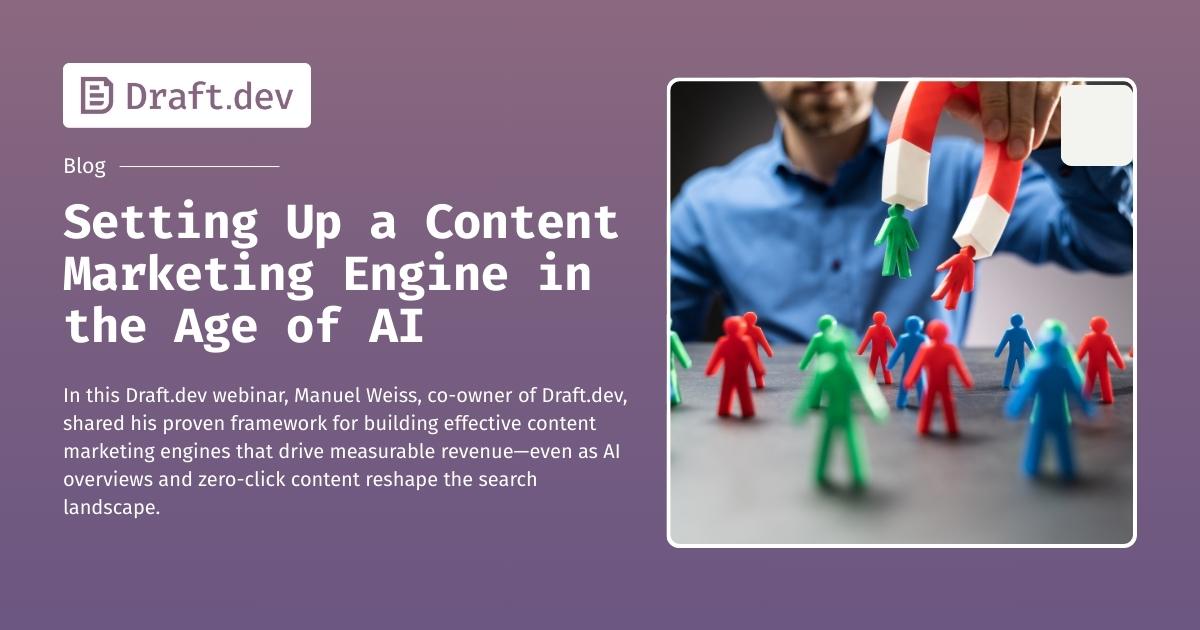In the first session of our latest Draft.dev webinar series, Manuel Weiss, co-owner of Draft.dev, shared his proven framework for building effective content marketing engines that drive measurable revenue – even as AI overviews and zero-click content reshape the search landscape. Drawing from over a decade of experience scaling content operations from startups to enterprise companies, Manuel outlined the essential systems and processes needed to succeed with technical audiences.
- Why Do Content Marketing Engines Matter More Than Ever?
- What Are the Five Essential Components of a Content Marketing Engine?
- How Do You Choose the Right Content Management System?
- What Should You Measure and Track in the AI Era?
- How Do You Convert Traffic into Known Leads?
- What Makes Retargeting Strategy Effective for Developers?
- Why Are Content Calendars Critical for Success?
- How Do You Prove ROI and Scale Your Content Program?
- What’s Different About Content Marketing in the AI Era?
- How Should You Get Started with Content Marketing?
- Answering Your Questions
- Conclusion
Why Do Content Marketing Engines Matter More Than Ever?
Content marketing success isn’t about inspiration striking or publishing the occasional perfect article. As Manuel emphasized throughout the session, it requires disciplined execution of proven systems and processes.
Content marketing needs to be a consistent, predictable growth channel. We want to avoid the “when inspiration strikes” approach… Really, marketers that fail to succeed at content marketing just lack the processes and systems and frameworks and the discipline. – Manuel Weiss
The stakes are higher now with AI overviews affecting click-through rates for technical content. Manuel shared data showing clear drops in organic traffic, making structured, long-term approaches more critical than establishing a reliable foundation that can weather these changes. For deeper insights into how AI is changing search behavior, Growth Memo’s UX study of Google’s AI overviews provides valuable data on user interaction patterns.
Understanding your target audience is crucial for any content strategy – learn more about strategies for business growth through developer ecosystems that resonate with technical professionals.
What Are the Five Essential Components of a Content Marketing Engine?

Manuel outlined five core systems that work together to create predictable content marketing results: content management systems, analytics setup, lead collection, retargeting strategy, and content calendars. Each component serves a specific purpose in the overall engine, but they must work in harmony to drive revenue.
How Do You Choose the Right Content Management System?
A proper CMS setup eliminates dependencies on technical resources and ensures non-technical team members can publish content following SEO best practices. Draft.dev recommends using static site generators like Next.js, paired with headless CMS solutions like Netlify.
For modern technical content publishing, consider these recommended platforms:
- Jamstack site generators: Explore options at Jamstack.org for fast, secure publishing
- Netlify with Next.js: Follow Netlify’s deployment guide for seamless integration
Key requirements include:
- Custom meta titles and descriptions
- Schema markup for AI overview citations
- Core Web Vitals compliance for preferential search rankings
- Subdirectory publishing to consolidate domain authority
It’s really important that non-technical people can preview, schedule and publish content in the way the best practices require us to publish the content. – Manuel Weiss
The CMS should enable publishing that builds domain authority over time. For companies already using platforms like HubSpot, Manuel warns about JavaScript bloat affecting page load speeds and Core Web Vitals scores, which impact search rankings.
Third-party platforms like Dev.to can supplement your content strategy but shouldn’t replace owned media. Use these communities for teaser content that links back to full articles on your domain, ensuring proper canonical URL attribution.
What Should You Measure and Track in the AI Era?

Traditional metrics remain important, but the AI era requires new measurement approaches. Essential metrics include:
- Unique visitors per month
- Average time on page
- Search impressions via Google Search Console
- Traffic from AI search engines (Perplexity, Claude, ChatGPT)
- Placement in AI overviews
Manuel cautioned against setting unrealistic goals initially, recommending at least six months of consistent publishing to establish meaningful benchmarks. The key is learning what content types resonate with your audience and doubling down on successful approaches.
To better understand how AI affects your content performance, Ahrefs provides a comprehensive guide to tracking AI traffic that helps measure visits from AI search engines like Perplexity and ChatGPT.
Understanding developer marketing fundamentals helps refine which metrics matter most for your specific technical audience.
How Do You Convert Traffic into Known Leads?
Converting anonymous traffic into known contacts enables relationship building with technical audiences. The key is providing genuine value through gated assets like benchmarking tools, security checklists, or interactive sandboxes.
It’s all about building relationship and providing value over time. We don’t want to be spammy… We want to create leads. – Manuel Weiss
Manuel recommends starting with simple tools like Mailchimp or Kit for budget-conscious teams, focusing on collecting first name and email address while maintaining a strong value-to-friction ratio. The goal isn’t immediate sales but building trust over time until prospects reach the right intent stage.
Recommended platforms for lead collection:
- MailChimp: Affordable option for email marketing and automation
- Kit: Creator-focused platform with strong automation features
- HubSpot: Comprehensive CRM solution for larger teams with bigger budgets
For technical audiences specifically, consider gating valuable resources that solve real problems developers face in their daily work.

What Makes Retargeting Strategy Effective for Developers?
Retargeting allows for sophisticated audience segmentation based on content consumption patterns. Manuel shared creative approaches like:
- URL-based audience building (capturing visitors to Python vs Ruby content)
- Exclude audiences to avoid serving ads to converted leads
- Brand awareness campaigns using logo and tagline impressions
One powerful example: capturing traffic spikes from platforms like Hacker News, then serving brand awareness ads to build recognition among developers who may not have noticed the company during their initial visit.
The impressions of the retargeting ads are free. So all of this brand awareness is completely free. Only when people click on the banner do we have to pay for it. – Manuel Weiss
This approach respects the audience by serving relevant content based on their demonstrated interests while avoiding spam-like behavior.
When implementing retargeting, ensure compliance with privacy regulations through proper consent management. Google’s Consent Mode implementation guide provides approved partners for GDPR and CCPA compliance. For advanced campaigns, explore dynamic remarketing best practices to personalize ads based on specific content consumed.
Why Are Content Calendars Critical for Success?
Content calendars enable planning and accountability while reducing reactive publishing. Manuel emphasizes building content buffers – having articles scheduled weeks or months in advance.
This is why this is so powerful… it opens up so many things because the friction is gone. You can act and not react. – Manuel Weiss
Benefits include:
- Predictable publishing schedules
- Advanced social media and newsletter planning
- Data-driven content strategy refinement
- Clear ROI reporting to leadership
The calendar approach allows teams to reverse engineer their capacity and commit to realistic publishing schedules. Manuel recommends starting with every-other-week publishing as a minimum viable rhythm.
For content calendar management, Trello’s Calendar Power-up provides excellent visualization and team coordination features. Alternative tools include Airtable, Asana, or simple spreadsheets – the key is consistency, not complexity.
For insights on maintaining consistency with technical content creation, consider working with subject matter experts who understand developer workflows.
How Do You Prove ROI and Scale Your Content Program?

Manuel outlined a clear attribution model for demonstrating content marketing impact:
- 8,000 unique blog visitors → 50 marketing qualified leads → 10 sales qualified leads → 3 opportunities → 1 closed deal
This reverse engineering approach helps justify budget increases and resource allocation by connecting content directly to revenue generation. Once you establish baseline metrics, you can predict how doubling content output should impact lead generation and revenue.
The key is having systems in place to track leads from first touch through closed deals, even using simple attribution rather than complex models.
What’s Different About Content Marketing in the AI Era?
While AI overviews present challenges, we see opportunities for marketers who adapt their strategies. Key adaptations include:
- Enhanced schema markup for AI citation eligibility
- Focus on domain and topical authority building
- Longer-term, consistent publishing approaches
- Advanced audience segmentation and retargeting
The fundamental approach remains the same – provide consistent value to technical audiences – but the tactics must evolve to ensure content gets discovered and credited in AI-powered search results.
Key developer communities for building brand awareness include Hacker News and Lobsters, where quality technical content can generate significant traffic spikes that feed into your retargeting audiences.
Companies investing in developer relations strategies alongside content marketing will be best positioned for this transition.
How Should You Get Started with Content Marketing?
For teams beginning their content marketing journey, Manuel recommends:
- Establish publishing rhythm – Commit to every-other-week publishing minimum
- Build content buffers – Create 6-8 week content reserves
- Use placeholders – Schedule publication dates before finalizing topics
- Focus on consistency over perfection – Maintain publishing momentum
- Implement measurement – Set up analytics and lead tracking from day one
At the beginning, publishing and creating a pulse, and an expectation is more important than the perfect article. – Manuel Weiss
The emphasis should be on building internal muscles for consistent execution rather than perfecting individual pieces of content.
Watch the entire webinar here:
Answering Your Questions
What Are Some Creative Retargeting Ideas for Technical Audiences?
Documentation-Based Segmentation: For product-led growth companies, create audiences based on which documentation sections visitors accessed. Serve different ads to users who viewed implementation guides versus those who only browsed overview pages.
Intent-Level Targeting: Track visitors who reached sign-up pages but didn’t convert. These users showed purchase intent but encountered friction – serve them content addressing common objections rather than generic product awareness ads.
Tech Stack Segmentation: Beyond Python vs Ruby URL targeting, create audiences based on specific technology combinations. If someone visited articles about Docker and Kubernetes, serve ads for container orchestration guides rather than generic DevOps content.
How Do You Actually Prove ROI of Content Marketing to Business Leadership?
Manuel outlined a clear attribution framework that doesn’t require complex tools:
Simple Funnel Tracking:
- 8,000 unique blog visitors → 50 marketing qualified leads → 10 sales qualified leads → 3 opportunities → 1 closed deal
Revenue Attribution: Track leads from first touch through closed deals using basic qualification criteria. For example, companies with 200+ engineers qualify for sales conversations, while smaller teams enter nurture campaigns.
Reverse Engineering Growth: Once you establish baseline metrics (like 50 MQLs from 8,000 visitors), you can predict that doubling content output should roughly double lead generation, providing clear budget justification.
The key is consistency over complexity – track the essential metrics religiously rather than implementing sophisticated attribution models that may not provide actionable insights.
Conclusion
This webinar represents the first in a multi-part series exploring modern content marketing strategies. The foundation outlined here – from CMS selection to content calendars – enables the advanced tactics covered in subsequent sessions, including optimizing developer content for success and funnel optimization strategies.
As the digital landscape continues evolving with AI integration, the companies that invest in robust, systematic content marketing engines will be best positioned to maintain competitive advantages and drive predictable revenue growth. Success comes not from perfect content, but from disciplined execution of proven systems over time.
For teams ready to implement these strategies, Draft.dev’s Building and Scaling Developer Marketing provides additional frameworks for scaling technical content operations. Book a free discovery call to learn more about what we do.
